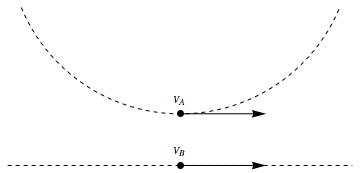Consider two particles moving in the same direction instantaneously but one of them follows a circular path and one follows a straight path.

If I adopt a rotating frame of reference in which the particle $A$ is stationary, math tells me that the relative speed between $A$ and $B$ is $V_{rel}=V_B-V_A-\frac{V_B h}{R}$, where $h$ is the distance between the particles and $R$ is the radius of the circular path.
I understand that this is right, I can infer this from the formulas of rotating reference systems. But can someone please explain why it doesn't work to simply take $V_A-V_B$. The relative velocity should be the difference between two velocity vectors, I think that's very intuitive. But in this case it isn't? Why? When I see a physical situation like this (e.g. they could be airplanes, one doing a loop), how can I know if I can simply take the difference between the velocity vectors to find the relative velocity or not?
